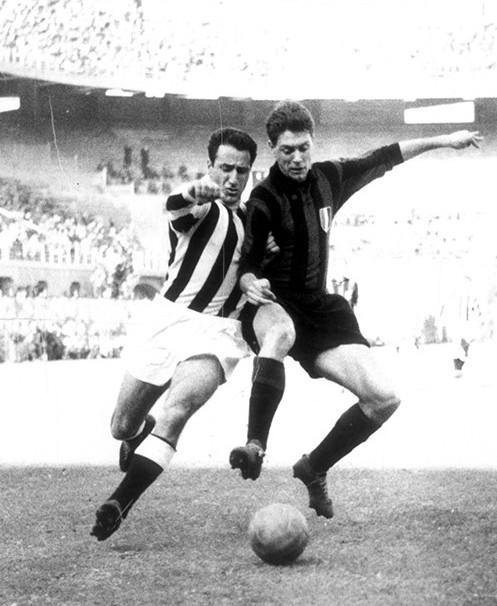Once league football was ready to resume in Italy following the Second World War, Udinese were inserted into one of the three groups (Veneto-Emilia) of the B-C tournament, featuring a total of 36 teams. Making his first appearances for Udinese during this time was Sergio Manente, who would go on to become a mainstay for Juventus, playing 231 times for the Turin-based side. Udinese continued to compete in this tournament until the 1947/48 season, when it was restructured into one league.
AFTER THE SECOND WORLD WAR
THE GIUSEPPE BERTOLI ERA AND SERIE A
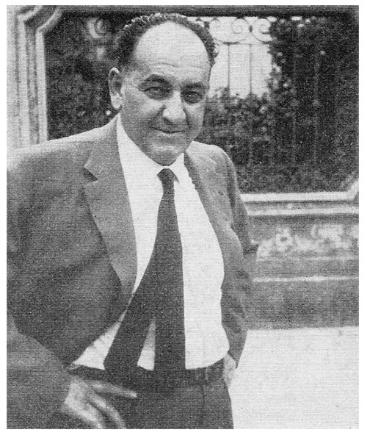
The start of the 1947/48 season brought with it significant developments at boardroom level. Guido Capelletto resigned as president and was replaced by the businessman Giuseppe Bertoli, who took on all of the club’s debt – nearly nine million lire. Bertoli – a man of clear ideas – would prove to be a key figure in the history of Udinese over the coming seasons. The Austrian Hermann Schramseis started the campaign as coach but was later replaced by Elio Loschi, who could only guide the team to tenth – not enough to avoid relegation down to Serie C.
Bertoli rolled up his sleeves, appointing former Udinese goalkeeper Aldo Olivieri – part of the Italy squad that won the 1938 World Cup – as coach and set about building a balanced if inexpensive team. The results quickly followed in the 1948/49 season and Udinese were soon back in Serie B and looking as if they had laid the necessary foundations for a tilt at the top tier. Bertoli signed the attacking trio of Giovanni Perissnotto, Stelio Darin and Silvano Dalle Vacche from Mestrina, while the Irishman Paddy Sloan joined from Torino. There were further significant signings in the form of the goalkeeper Marco Brandolin from Lazio, Marino Bergamasco from Pro Gorizia, Giuseppe Farina from Chieti, and Luigi Zorzi and Oscarre Vicich, both of whom joined from Sampdoria.
For Luigi Zorzi, it was a reunion with his local club – the club where he had taken his first steps in the world of senior football. Udinese stuck with a number of their experienced players too, none more so than Severino Feruglio – something of an icon for the club – who would play a key role in Udinese’s promotion charge.
The 1949/50 season itself was a roaring success. Udinese finished second, on 60 points, one shy of champions Napoli. They had reached the promised land of Serie A.
The majority of the squad was kept as it was, but coach Aldo Olivieri would not be joining the team in Serie A – he had departed for Inter. His successor was Guido Testolina, a coach with a reputation for defensive football. Sloan left to be replaced by Erling Soerensen, while Italo Acconcia joined from Fiorentina, Franco Marchi was signed from Bologna, Giuseppe Rinaldi and Gianni Toppan came in from AC Milan and Giancarlo Forlani and Ottorino Paulinich signed from Reggiana and Cremonese respectively.
Udinese performed admirably in Serie A in 1950/51, finishing the season ninth out of 20. But their task would be made harder the following season, as the rules were changed so that three teams would be relegated instead of just two. That risk was mitigated somewhat thanks to some good work in the transfer market, however, not least in the case of Giancarlo Bacci, the attacking midfield player signed from Roma. Another good signing was that of Amos Mariani from Atalanta, a lively right winger, while Ercole Castaldo joined from Salernitana, Silvano Moro was signed from Pro Gorizia, Johannes Ploeger came in from Juventus and Renato Toso was signed from Inter. Udinese started the 1951/52 season in decent form, but a 7-2 home defeat by Juventus saw Guido Testolina replaced by Severino Feruglio, who managed to steer the team to a respectable eleventh.
From Bertoli to Dino Bruseschi
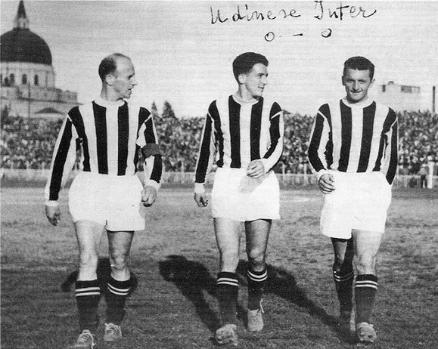
After the end of the 1951/52 season, Giuseppe Bertoli decided to hand over control of the club to his son-in-law, Dino Bruseschi, a leading player in the Palmanova wood industry. Bertoli remained part of the Udinese family, though, becoming honorary president. His faith in Bruseschi proved to be well placed as the new president quickly demonstrated his negotiating prowess, succeeding in bringing Aldo Olivieri back from Inter and sending the midfielder Germano Travagini to AC Milan in exchange for Enzo Menegotti, plus a tidy sum. Toni Bacchetti joined from Napoli, bringing his laid-back, mercurial style to the squad, while the goalkeeper Antonio Pin was brought in from Mestrina and Aldo Vascellari signed from Treviso. The team performed well, up until April 1953, when two consecutive defeats saw them slip towards the relegation zone. A 3-2 win over Pro Patria on the final day of the season meant they preserved their Serie A status for another year – although it later emerged that there was more to the result than met the eye.
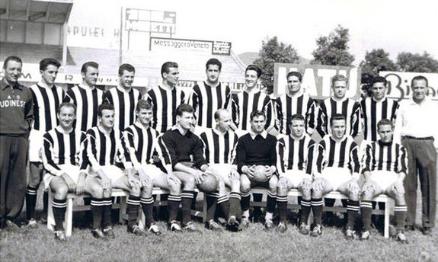
Bruseschi appointed Peppino Bigogno as coach ahead of the following season, while goalkeeper Livio Puccioni and midfielder Giovanni Invernizzi joined from Inter along with Rodolfo Bertrandi from Fiorentina, Marco Zamboni from Brescia, Gianni Romano from Venezia, Alberto Orzan from Pro Gorizia and Giosue Stucchi from Vigevano. The president also held onto the Swedish forward Arne Selmosson, but a Prime Ministerial Decree would (temporarily) prevent the player from playing in Italy.
The 1953/54 season was a disappointing one, and Udinese needed the play-offs to secure their Serie A status for another year. The side responded well when it mattered, beating SPAL 2-0 in Milan before drawing 1-1 with Palermo in Florence. The only real positive note from the campaign was the emergence of Giuseppe Virgili, a local lad who notched nine league goals that year to establish a reputation as one of the most promising youngsters in the league. Virgili had made his debut the year beforehand, in a 0-0 draw away at Como, but had made only one other appearance that season, in a 4-0 defeat away at Juventus.
1955: ON THE BRINK OF TITLE GLORY
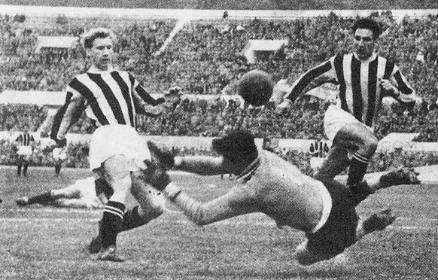
Giuseppe Virgili joined Fiorentina in the summer of 1954, establishing himself as a top striker and playing a key role in Fiorentina’s first Serie A triumph the following year. President Bruseschi signed Lorenzo Bettini from Roma to replace him. Bettini was coming off the back of a poor season in the capital, but Bruseschi’s intuition would be proved right once again as Bettini developed into a worthy heir to Virgili.
Udinese also got the green light to register Selmosson, while the cultured midfielder Augusto Magli joined from Fiorentina, Gianfranco Dell’Innocenti came in from SPAL, the pacey winger Domenico La Forgia was signed from Bologna and Remo Morelli joined from Legnano. Udinese made a slow start, losing 2-0 at home against Inter on the first day of the season, followed by a 3-1 defeat by Napoli and a 5-0 loss to Catania. Defensive reinforcements were clearly necessary, and sure enough Umberto Pinardi was brought in from Juventus in November.
The signing of Pinardi proved to be the turning point. The team had greater balance, with the defence acquiring newfound solidity and the attack growing in confidence. Udinese slipped to a 2-0 defeat away at Sampdoria on 12 December 1954, but that would be the last time the team lost that season. With every passing game, Udinese cut the gap with the AC Milan of Gunnar Nordahl, Juan Alberto Schiaffino, and Nils Liedholm, who began to falter. By 1 May, when Udinese welcomed AC Milan to the Moretti, the title race was red hot. Udinese had 35 points, AC Milan 39. It felt as though all of Italy was behind Udinese, the underdog on the verge of a miracle.
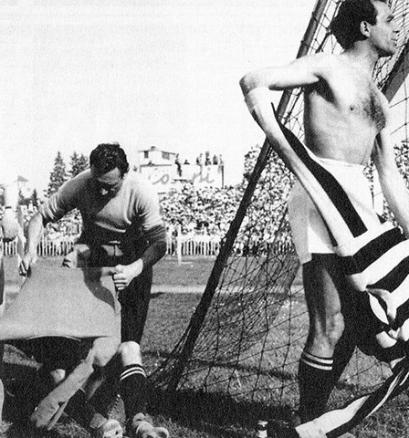
That clash with AC Milan proved to be one of the most famous matches in Udinese history as the team defeated the Rossoneri in front of 25,000 rapturous fans, despite having to play almost half the game without their goalkeeper Gianni Romano. Romano had been injured in a clash with Gunnar Nordahl and had to be replaced between the sticks by midfielder Augusto Magli, with no substitutions allowed in those days. Other teams might have crumbled in similar circumstances, but Udinese’s superior fitness did them proud and they managed to hang on for a 3-2 win. The result meant Udinese were in with a chance of overtaking AC Milan and – just maybe – finishing the job winning the title itself, but it wasn’t to be. Disappointing draws with Pro Patria, Novara and Torino followed that famous win, while AC Milan bounced back to finish as champions on 48 points, four ahead of Udinese in second.

RELEGATION TO SERIE B
A series of “strange” results towards the end of the 1954/55 season had led to controversy over the spectre of match-fixing. During their investigations, FIGC discovered that there had been irregularities in the Pro Patria v Udinese game two years previously, which we mentioned earlier. On 1 August 1955, FIGC ruled that Udinese were to be relegated to Serie B as punishment.
The Udinese fans flocked to Piazza Liberta in protest, leading to fears that violence could break out, but thankfully the demonstrations passed without event. The court of appeal upheld the original verdict, and the day held yet more bad news for Udinese as the club’s vice president, Arrigo De Pauli, was killed in a road accident alongside his secretary Mario Criscuolo as the two were driving to Turin
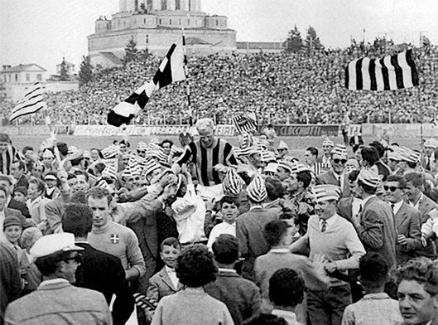
Lorenzo Bettini and Arne Selmossen departed for Lazio in the summer of 1955, while Domenico La Forgia and Gianfranco Dell’Innocenti joined Bologna, Laszlo Szoke signed for Triestina and Luigi Zorzi retired ahead of Udinese’s first season back in Serie B. The Norwegian striker Per Bredesen was brought in along with the striker Giuseppe Secchi and the two played an integral role in a scintillating 1955/56 season for Udinese, who won all 17 home games on their way to a convincing title triumph.
Udinese held their own in Serie A in the years that followed, notably finishing fourth in the 1956/57 season and eighth in the 1957/58 season (level with Inter and AC Milan), with Swedish player Bengt Lindskog proving his importance as the team’s lynchpin in both of those campaigns. Yet after those impressive highs, Udinese began to find it harder and harder to preserve their Serie A status each year, with relegation only avoided in the 1960/61 season after a play-off with Bari and Lecce. Striker Lorenzo Bettini was a key man for the side in the late 1950s, with the half Italian, half Argentine right winger Luis Pentrelli – signed in July 1957 – providing him with plenty of ammunition. Other players to represent Udinese during this time were Luciano Pique, Mario Pantaleoni, Amleto Frignani, Enzo De Giovanni, Francesco Canella and the aforementioned Bengt Lingskog. Lingskog would later join Giuseppe Bigogno at Inter, but he did a fine job of filling the shoes of Arne Selmosson at Udinese before that. Massimo Giacomini – a midfielder with great vision but limited pace – also made his debut for the team in the late 1950s (13 October 1957 in a 1-1 home draw with AC Milan, to be precise).
